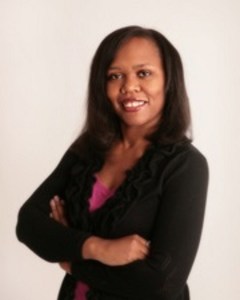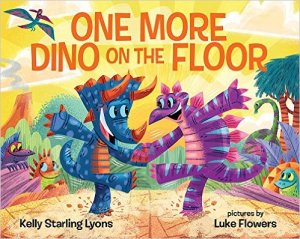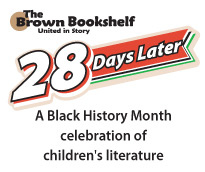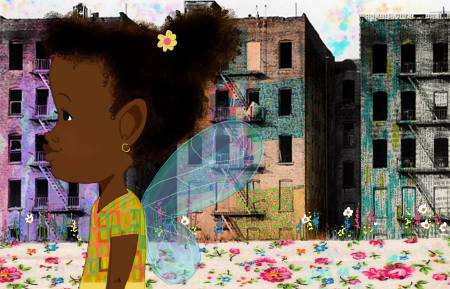As Laurie Edwards promised in her February 3 post, Daring to be Different, today we welcome Kelly Starling Lyons. She is here to talk about The Brown Bookshelf, a website dedicated to highlighting African American children’s authors and illustrators..

Kelly Starling Lyons is a children’s book author whose mission is to transform moments, memories and history into stories of discovery. Her books include chapter book, NEATE: Eddie’s Ordeal; CCBC Choices-honored picture book, One Million Men and Me; Ellen’s Broom, a Coretta Scott King Illustrator Honor book, Junior Library Guild and Bank Street Best selection and Tea Cakes for Tosh and Hope’s Gift, Notable Social Studies Trade Books for Young People. Her latest picture book is One More Dino on the Floor. Jada Jones, her new chapter book series, debuts in September.

How did The Brown Bookshelf come about?
The Brown Bookshelf was founded by young adult authors Paula Chase-Hyman and Varian Johnson. As they launched their kidlit careers, they noticed a disturbing reality – many people had never heard of the wonderful books by black children’s book creators that were available. Paula and Varian wanted to start an initiative that would celebrate authors of color and be a resource for children, parents, teachers and librarians. Inspired by Readergirlz, they created The Brown Bookshelf to “push awareness of the myriad Black voices writing for young readers.”
How did you get involved?
Paula invited me and author Carla Sarratt. Varian invited author/illustrator Don Tate. I was thrilled to join a team dedicated to saluting black children’s book creators. Together, we kicked off the inaugural 28 Days Later campaign, a Black History Month celebration of under-the-radar and vanguard authors and illustrators.

Who are the current members?
They are: Varian Johnson, Paula Chase-Hyman, Don Tate, Kelly Starling Lyons, Tameka Fryer Brown, Gwendolyn Hooks, Olugbemisola Rhuday-Perkovich, Crystal Allen, Tracey Baptiste, and Jerry Craft.
How did the 28 Days Later campaign start?
Paula and Varian came up with the idea for the campaign. We invited the public and publishers to submit nominations of black authors and illustrators with new books or those that had flown under the radar. We researched those suggestions, made internal recommendations and voted on the first class of honorees. Over the years, we’ve generally followed that model as we search for outstanding authors and illustrators to feature. The goal is to give parents, librarians and teachers a month of spotlights celebrating stand-outs in the kidlit world. We want to draw attention to black children’s book authors and illustrators and get their great books into the hands of kids.
What has been the response?
Every year, the response inspires us to keep going. Many people share our posts and use them as a resource for making sure their school, library and home children’s book collections match our diverse world. We hear from parents who longed to buy books that reflected their kids but had no idea how many existed until they found our site. We’ve received notes from students who have used our profiles for research for school projects. Sometimes our spotlights are the main source for information about a black children’s book creator outside of that person’s website. It’s heartwarming and affirming to know we’re making a difference. It’s also a challenge to keep pushing and giving back.

This is the tenth year for 28 Days. How will it be different this year?
In celebration of our tenth campaign, we’re doing a different format. In past years, we’ve honored eight picture book authors, eight middle-grade authors, eight young adult authors and four illustrators. This year, we’ve arranged our spotlights around themed weeks. The campaign opened with books for younger readers, featuring debut and under-the-radar picture book creators. The second week, we focused on books for older readers – middle-grade and YA authors. The third week, our theme was social justice. The last week of our campaign is inspiration week where we interview or pay tribute to children’s book creators who have paved the way for us.
How have the careers of your featured authors progressed?
One of the beautiful parts of being a member of The Brown Bookshelf is seeing the careers of black children’s book creators flourish and bloom. We featured Kwame Alexander before the Newbery, Jacqueline Woodson before the National Book Award, Javaka Steptoe before the Caldecott, Jason Reynolds back when Kirkus called him “an author worth watching.” It fills us with pride to see authors like these and others soar. Every award they win, every starred review, every accolade, is a lift for all and reminder that our books matter.
On the other side though, there are amazing black authors and illustrators whose stories are still not receiving the audience they deserve. There are veteran black children’s book creators who struggle to land deals, whose books lack the marketing support to grow a large audience, whose important books are overlooked and eventually go out of print. Our mission is to raise awareness of their work and make sure they’re honored too. We need equity in the children’s book publishing world. We have a long way to go.
What prompted the Declaration in Support of Children?
We had been trying to find a way to collectively express our outrage at the systemic racism and brutality that was devastating our kids and affirm our commitment to standing with them and for them. One of the ideas we brainstormed was an open letter. Team member Tameka Fryer Brown did an amazing job with the draft. We revised and added our thoughts. The election gave our letter even more urgency. It became an open declaration letting kids know we have their backs.
“ . . . The stakes are too high for us to be silent. The stakes are too high for us to wait for someone else to take the lead. The stakes are too high for us to just hope things will get better. Each day, we see attempts to disenfranchise and dehumanize marginalized people and to dismiss the violence that we face. As children’s book creators, we feel a special connection and responsibility to amplify the young voices that too often go unheard . . .”
We invited others to join us in our mission to “to promote understanding and justice through our art; to bolster every child’s visceral belief that his or her life shall always be infinitely valuable.”

Illustration by Vanessa Brantley-Newton
What has been the response?
The outpouring of support we received was incredible. Nearly 700 people signed the initial declaration with hundreds more signing the living document on our Facebook page. Our declaration was covered by School Library Journal, The Guardian and more. We’re inspired and thrilled at the hundreds of people who pledged to stand again hate and stand up for kids.
Brown Bookshelf member Olugbemisola Rhuday-Perkovich has been leading important roundtable discussions called Where Do We Go From Here? about how to put our declaration into action. You can see them here and here. Stay tuned for more.

What does the future hold for the Brown Bookshelf?
The future is limitless. We are always thinking of ways to amplify the work of black children’s book creators, support and honor the voices of children and be of service to parents librarians and teachers.
Our 28 Days Later spotlights are always available on our website. But our most recent project was working with TeachingBooks.net to showcase our features and their additional resources for our 28 Days Later honorees (Links here and here).
Another new project was expanding our social media presence. You can find us on Facebook, Twitter, Instagram, and YouTube.
We’ll have more news to share in coming months. We’re honored to be featured here. Thank you for spreading the word about what we do. That we’ve been around for a decade is a testament to the support of great people like you.
Like this:
Like Loading...








 elp me understand the culture of military families and maritime professions. And I have used cultural consultants to help me more fully understand characters who share my own ethnicity and religion. Membership in the race, ethnicity, or religion of your characters doesn’t automatically
elp me understand the culture of military families and maritime professions. And I have used cultural consultants to help me more fully understand characters who share my own ethnicity and religion. Membership in the race, ethnicity, or religion of your characters doesn’t automatically







